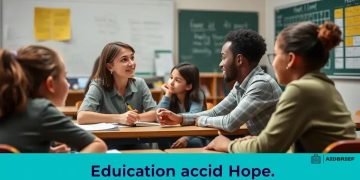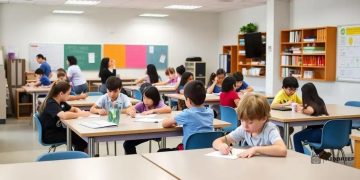Public backlash against education policy changes raises concerns

Public backlash against education policy changes reflects community concerns over funding, curriculum adjustments, and teacher evaluations, prompting calls for greater transparency and collaboration among stakeholders.
Public backlash against education policy changes is becoming more pronounced as parents, teachers, and students express their concerns. Have you noticed how heated discussions have become around school board meetings? Let’s explore the root of this tension and what it means for our educational future.
Understanding the recent education policy changes
Understanding the recent education policy changes is crucial for everyone involved in the academic environment. These changes are often driven by the need for reform and improvement in our education system. Recently, many stakeholders have voiced their opinions on how these policies affect students, teachers, and parents alike.
Key aspects of the changes
Several critical areas have been impacted by these new policies. They aim to address issues such as funding, curriculum standards, and teacher evaluations. Highlighting these areas can help clarify their implications.
- Funding allocations: Changes in budget distribution often lead to varying impacts on schools across different districts.
- Curriculum updates: New guidelines are reshaping what students learn and how teachers are expected to deliver this content.
- Teacher evaluations: Performance metrics for educators are being adjusted to ensure accountability and effectiveness.
These changes do not come without their challenges. Often, communities face disruptions and uncertainty as they adapt. Parents and educators have expressed concern over how swiftly these policies are being implemented. Many argue that more time and resources are necessary for successful transitions. Collaborative discussions between stakeholders can ease these tensions.
The role of community feedback
Community input plays a significant role in shaping these education policy changes. Parents, teachers, and students are invaluable resources in understanding the needs of the educational system. Listening to their feedback has encouraged policymakers to reconsider certain aspects to make improvements. Surveys and town hall meetings have become platforms for addressing critical issues.
Engagement from all sides can foster a more supportive environment. As educators adjust to new standards, it is essential for them to have a say in how these policies will affect their classrooms. Communication channels must remain open, allowing for honest and constructive feedback.
Looking towards the future
The future of education policies is still being written. As we strive to enhance learning experiences, the involvement of every stakeholder remains critical. By embracing the public backlash and understanding its roots, we can work towards policies that better serve our communities and fulfill the educational needs of all students.
The reasons behind public backlash
The reasons behind the public backlash against education policy changes are multifaceted and significant. As new policies are implemented, various stakeholders such as parents, teachers, and students express their thoughts and feelings about these adjustments.
Key factors influencing backlash
Public opinion often shifts in response to several key factors. Understanding these drivers can help clarify why tensions are rising.
- Lack of communication: When policymakers fail to communicate changes effectively, mistrust can grow among the community.
- Negative impact on students: Parents worry that abrupt policy shifts may hinder their children’s educational success and well-being.
- Perceived unjust evaluations: Educators may feel that new evaluations do not accurately reflect their teaching abilities, leading to dissatisfaction.
As these issues surface, many community members voice their concerns openly. School board meetings become heated as parents express their fears about these changes. Teachers often join the conversation, explaining how mandated alterations can undermine their methods. This vibrant discourse shows how passionate everyone is about ensuring quality education.
The role of social media
Social media platforms have amplified voices, allowing concerns to reach a wider audience quickly. Conversations that once happened in local gatherings now thrive online, where posts can go viral. This immediacy can escalate tensions when negative feelings outweigh positive feedback. People share their stories, prompting others to join in and express similar sentiments.
Public backlash often grows within these digital spaces, as parents and teachers rally support for their positions. Campaigns and hashtags effectively mobilize individuals, creating a unified front against perceived negative changes. This dynamic can lead to significant pressure on policymakers to reconsider their decisions and engage more thoroughly with constituents.
Impact of policy changes on students and teachers

The impact of policy changes on students and teachers can be profound and far-reaching. As educational policies evolve, both students and teachers face a variety of challenges that can affect their experiences in the classroom.
Effects on students
Students may experience a mix of positive and negative outcomes from these policy changes. Some students may benefit from updated curriculum standards that promote critical thinking and creativity. However, many may struggle with adjustments that challenge their learning styles.
- Increased pressure: New assessment standards can create anxiety and stress among students, affecting their performance.
- Equity concerns: Changes to funding may lead to disparities in resources available to different schools, impacting students’ access to quality education.
- Curriculum gaps: If policies shift too quickly, students might find themselves unprepared for new subjects or standards.
It’s essential to be aware of these issues, as they highlight the potential risks involved in implementing education policies. Students’ voices are crucial in these conversations, as they can provide insight into how changes affect their daily learning.
Effects on teachers
Teachers also feel the effects of policy changes significantly. They are often at the front lines, adapting to new methods and expectations. The shifting landscape can lead to frustration if educators do not receive adequate training or resources.
- Professional development: Teachers may require ongoing training to effectively adapt to new policies, which can be hindered by budget constraints.
- Job security: Changes in evaluation methods may cause uncertainty regarding job performance and stability for educators.
- Teaching autonomy: Policies that dictate curriculum can limit teachers’ creative freedom and ability to tailor lessons to their students’ needs.
The interplay between policy changes and their impact on student learning and teacher effectiveness is complex. Continuous dialogue among all stakeholders is essential to ensure that education policies foster a positive environment conducive to learning.
Case studies of communities responding to changes
Case studies of communities responding to changes in education policy provide valuable insights into how different groups adapt. Each community’s response often reflects its unique values, needs, and circumstances, showing the diverse ways people can come together for a common cause.
Community A: Advocating for Transparency
In Community A, parents and teachers banded together after learning about sudden changes to the school funding model. They organized town hall meetings to discuss their concerns and demanded more transparency from school leaders. Through petitions and public comments, they highlighted the adverse effects on local schools, especially in underfunded areas.
- Mobilization efforts: Community members used social media to raise awareness and share personal stories, creating a powerful narrative.
- Collaborative actions: Workshops and training sessions informed parents about school finance, empowering them to engage in discussions with officials.
- Impact: Their efforts resulted in a revised funding strategy that took community input into account.
This case shows the importance of community advocacy when confronting educational changes. By uniting, they were able to create positive outcomes for their schools.
Community B: Innovating Through Challenges
In another example, Community B faced a shift towards standardized testing that many believed would harm student creativity. Instead of accepting the changes passively, local educators formed a coalition to develop new teaching methods that aligned with the new policies yet promoted engagement.
- Creative solutions: Teachers began using project-based learning to enhance critical thinking alongside test preparation.
- Parent involvement: Workshops were held to educate parents about the new expectations and how they could support their children.
- Results: Student performance improved, not just on tests, but also in creative capacities.
This proactive approach demonstrates how innovation can emerge from adversity, showcasing the importance of adaptability in educational environments.
Both communities illustrate how collective action, communication, and creativity can lead to effective responses to policy changes. Sharing experiences fosters hope and collaboration in tackling educational challenges.
Looking ahead: potential outcomes and solutions
Looking ahead at the potential outcomes and solutions regarding education policy changes is essential for students, teachers, and community members alike. As society continues to voice concerns about the effectiveness of these policies, it is crucial to explore what may come next and how the challenges can be addressed.
Positive outcomes of community involvement
One potential outcome is increased community involvement in educational decisions. As people become more aware and vocal about their opinions, schools may adopt more participatory approaches. Collaboration between parents, teachers, and school administrators can foster trust and ensure that policies reflect the needs of students.
- Enhanced communication: Improved dialogue among stakeholders can lead to clearer understanding and shared goals.
- Tailored policies: Policies designed with community input can better address local challenges and strengths.
- Sustained engagement: Ongoing involvement of parents and educators can create lasting changes and foster a sense of ownership.
This shift towards collaboration holds the promise of more effective education systems.
Innovative solutions to challenges
As challenges arise from policy changes, innovation can emerge as a powerful response. Schools might implement new teaching methods, incorporate technology, and develop creative programs to address gaps. Science, technology, engineering, and mathematics (STEM) education, for example, could be expanded to engage students and prepare them for future job markets.
- Integrating technology: Utilizing digital tools can enhance learning and make education more accessible.
- Flexible learning environments: Adapting classrooms to support various teaching styles can benefit diverse learners.
- Focus on mental health: Policies that prioritize student well-being can create a healthier learning environment.
By investing in these solutions, schools can turn obstacles into opportunities, enhancing the learning experience for all.
Ultimately, looking ahead means being proactive and adaptable. By anticipating potential outcomes and fostering collaborative solutions, communities can create a brighter future in education.
In conclusion, the ongoing discussion about education policy changes is vital. Communities are showing resilience and creativity in addressing the challenges that arise. By staying engaged and working together, they can lead to positive outcomes for students and teachers alike. It’s clear that active participation, innovative solutions, and strong communication are key factors to ensuring that education remains effective and equitable. As we look to the future, it’s essential to keep the conversation going and explore new ways to improve our educational systems.
FAQ – Frequently Asked Questions about Education Policy Changes
Why is community engagement important in education policy?
Community engagement helps ensure that policies reflect the needs and concerns of those affected, leading to more effective outcomes.
What are some positive outcomes of education policy changes?
Positive outcomes include increased collaboration between parents and schools, tailored solutions for local issues, and improved student support.
How can innovation address challenges in education?
Innovation may introduce new teaching methods and programs that align with current policies while enhancing student engagement and learning.
Why is open communication essential in educational settings?
Open communication fosters trust among stakeholders, ensuring that everyone’s voice is heard and considered in the policy-making process.





